Please download PDF from above for the following currencies.
Australian dollar // New Zealand dollar //Canadian dollar // Norwegian krone // Swedish Krona // Swiss franc // Czech koruna // Hungarian forint //Polish zloty // Romanian leu // Russian rouble // South African rand // Turkish lira // Indian rupee // Indonesian rupiah // Malaysian ringgit // Philippine peso //Singapore dollar // South Korean won // Taiwan dollar // Thai baht // Vietnamese dong // Argentine peso // Brazilian real // Chilean peso // Mexican peso // Crude oil // Saudi riyal // Egyptian pound
Monthly Foreign Exchange Outlook
DEREK HALPENNY
Head of Research, Global Markets EMEA and International Securities
Global Markets Research
Global Markets Division for EMEA
E: derek.halpenny@uk.mufg.jp
LEE HARDMAN
Senior Currency Analyst
Global Markets Research
Global Markets Division for EMEA
E: lee.hardman@uk.mufg.jp
LIN LI
Head of Global Markets Research Asia
Global Markets Research
Global Markets Division for Asia
E: lin_li@hk.mufg.jp
MICHAEL WAN
Senior Currency Analyst
Global Markets Research
Global Markets Division for Asia
E: michael_wan@sg.mufg.jp
LLOYD CHAN
Senior Currency Analyst
Global Markets Research
Global Markets Division for Asia
E: lloyd_chan@sg.mufg.jp
EHSAN KHOMAN
Head of Commodities, ESG and Emerging Markets Research – EMEA
DIFC Branch – Dubai
E: ehsan.khoman@ae.mufg.jp
CARLOS PEDROSO
Chief Economist
Banco MUFG Brasil S.A.
E: cpedroso@br.mufg.jp
MAURICIO NAKAHODO
Senior Economist
Banco MUFG Brasil S.A.
E: mnakahodo@br.mufg.jp
MUFG Bank, Ltd.
A member of MUFG, a global financial group
June 2024
KEY EVENTS IN THE MONTH AHEAD
1) HEAVY CENTRAL BANK SCHEDULE
The US dollar weakened by 1.5% (DXY basis) in May despite the focus on the Fed’s policy rate remaining ‘higher for longer’. There will be greater clarity on the monetary policy outlooks over the coming month with no fewer than eight G10 central banks meeting in June. Only the Riksbank and the RBNZ will not be meeting. The easiest to predict is the ECB with clear and consistent guidance of a 25bp rate cut being delivered this coming Thursday. The FOMC announcement on 12th June will be key for the markets especially given the Summary of Economic Projections will be released. Whether the median dot profile for 2024 drops from three cuts to two or one will likely determine the initial reaction. The health of the labour market in the NFP data, released on 7th June, could well shape the 2024 dot profile. The messaging from the Fed, given we appear close to shifting from rate cuts later in the year to a possible need for a hike, will be crucial in shaping policy expectations. We see enough in other labour market data to assume a continued moderation in jobs and inflation that allows for rate cuts to unfold, by September most likely although even July remains just about feasible. We expect the BoC to cut by 25bps and after a recent speech from SNB President Jordan we now expect the SNB to hold off cutting but that’s a close call. Other central banks are set to stay on hold.
2) BOJ ON HOLD BUT JGB BUYING TO BE TAPERED
While the BoJ is set to announce an unchanged monetary stance in terms of the overnight call rate (we still expect a 15bp hike in July) we expect the BoJ to signal a change in stance related to its JGB buying operations. Purchases have been relatively stable at about JPY 6trn per month and the BoJ will likely signal an intention to reduce the pace of monthly purchases. That pace of monthly buying has kept total JGB holdings stable at around JPY 590trn and a slowdown in the pace will result in holdings starting to decline. The BoJ may avoid announcing a specific plan to taper like other central banks have done and instead commit to slowing the pace of purchases in a manner that ensures continued bond market stability. This provides the BoJ the greatest scope for flexibility during at least the initial stages of reducing JGB holdings. The yen may drive moderate support from this but lower yields abroad remains the more important determinant of JPY direction.
3) BOND ISSUANCE, PROPERTY POLICIES AND IMPLEMENTATION
Two weeks ago, the Chinese government issued a comprehensive set of property policies, trying to ensuring housing delivery, destocking housing inventory and stimulating housing demand by lowering down payments and removing the minimum mortgage rates. The implementation of these positive policies is the key. While this year’s fiscal policy stance is proactive with sizeable quotas for special bonds and ultra-long government bonds, the issuance of them and the growth of government expenditure has actually been behind the pace of previous years. We expect the government to expedite issuance and spending in Q3.
Forecast rates against the US dollar - End-Q2 to End-Q1 2025
|
Spot close 31.05.24 |
Q2 2024 |
Q3 2024 |
Q4 2024 |
Q1 2025 |
|
|
JPY |
157.22 |
154.00 |
152.00 |
150.00 |
148.00 |
|
EUR |
1.0846 |
1.0800 |
1.1000 |
1.1200 |
1.1200 |
|
GBP |
1.2725 |
1.2710 |
1.2870 |
1.3020 |
1.2870 |
|
CNY |
7.2421 |
7.2400 |
7.2200 |
7.1800 |
7.1500 |
|
AUD |
0.6637 |
0.6600 |
0.6800 |
0.6950 |
0.7000 |
|
NZD |
0.6134 |
0.6100 |
0.6200 |
0.6300 |
0.6300 |
|
CAD |
1.3644 |
1.3800 |
1.3600 |
1.3400 |
1.3200 |
|
NOK |
10.512 |
10.556 |
10.545 |
10.179 |
10.089 |
|
SEK |
10.532 |
10.648 |
10.545 |
10.179 |
10.089 |
|
CHF |
0.9035 |
0.9170 |
0.9090 |
0.9020 |
0.9110 |
|
|
|
|
|
|
|
|
CZK |
22.767 |
22.960 |
22.450 |
21.880 |
21.880 |
|
HUF |
359.53 |
363.00 |
359.10 |
356.30 |
360.70 |
|
PLN |
3.9394 |
3.9350 |
3.8820 |
3.8390 |
3.8840 |
|
RON |
4.5853 |
4.6110 |
4.5550 |
4.5000 |
4.5180 |
|
RUB |
90.059 |
91.220 |
91.390 |
92.030 |
94.880 |
|
ZAR |
18.825 |
18.750 |
19.000 |
18.750 |
18.500 |
|
TRY |
32.210 |
32.500 |
33.500 |
35.500 |
37.000 |
|
|
|
|
|
|
|
|
INR |
83.460 |
83.300 |
82.500 |
82.000 |
81.500 |
|
IDR |
16250 |
16200 |
15900 |
15700 |
15650 |
|
MYR |
4.7050 |
4.8000 |
4.7500 |
4.6000 |
4.5700 |
|
PHP |
58.501 |
59.000 |
58.500 |
58.000 |
57.500 |
|
SGD |
1.3519 |
1.3500 |
1.3350 |
1.3200 |
1.3000 |
|
KRW |
1385.5 |
1375.0 |
1350.0 |
1330.0 |
1310.0 |
|
TWD |
32.451 |
32.300 |
32.100 |
31.800 |
31.450 |
|
THB |
36.811 |
36.500 |
35.700 |
35.300 |
35.000 |
|
VND |
25449 |
25800 |
25900 |
25950 |
26000 |
|
|
|
|
|
|
|
|
ARS |
895.22 |
915.00 |
1000.0 |
1600.0 |
1700.0 |
|
BRL |
5.2412 |
5.1300 |
5.1000 |
4.9500 |
4.9500 |
|
CLP |
918.25 |
955.00 |
960.00 |
960.00 |
960.00 |
|
MXN |
17.036 |
17.300 |
17.400 |
17.500 |
17.600 |
|
|
|||||
|
Brent |
81.61 |
86.00 |
88.00 |
91.00 |
95.00 |
|
NYMEX |
77.27 |
81.00 |
83.00 |
86.00 |
90.00 |
|
SAR |
3.7507 |
3.7500 |
3.7500 |
3.7500 |
3.7500 |
|
EGP |
47.220 |
46.000 |
45.000 |
45.500 |
45.800 |
Notes: All FX rates are expressed as units of currency per US dollar bar EUR, GBP, AUD and NZD which are expressed as dollars per unit of currency. Data source spot close; Bloomberg closing rate as of 4:30pm London time, except VND which is local onshore closing rate.
US dollar
|
Spot close 31.05.24 |
Q2 2024 |
Q3 2024 |
Q4 2024 |
Q1 2025 |
|
|
USD/JPY |
157.22 |
154.00 |
152.00 |
150.00 |
148.00 |
|
EUR/USD |
1.0846 |
1.0800 |
1.1000 |
1.1200 |
1.1200 |
|
Range |
Range |
Range |
Range |
||
|
USD/JPY |
150.00-165.00 |
148.00-163.00 |
146.00-161.00 |
144.00-159.00 |
|
|
EUR/USD |
1.0500-1.1200 |
1.0600-1.1400 |
1.0700-1.1600 |
1.0800-1.1700 |
MARKET UPDATE
In May the US dollar weakened against the euro in terms of London closing rates, from 1.0692 to 1.0846. The dollar weakened much more modestly vs the yen, from 157.45 to 157.22. The FOMC at its meeting in May left the fed funds rate unchanged in a range of 5.25% to 5.50%. The FOMC continued with its policy of reducing its securities holdings with QT ongoing but reduced the pace from USD 95bn worth of securities to USD 60bn through reducing UST bonds from USD 60bn to USD 25bn. The pace of reduction in the holdings of MBS was left unchanged at USD 35bn per month. The reduction was in line with guidance already signalled to the markets.
OUTLOOK
The US dollar weakened in May with two key data releases the primary events that helped lower US yields – the jobs report and the CPI data were two days of sharp declines in 2yr UST note yields but throughout most of the rest of the time, yields were retracing those moves higher. That reflected the reality that while the jobs and CPI data were weaker, the need for the Fed’s policy rate to remain ‘higher for longer’ continues. The minutes from the May FOMC meeting also revealed a more intense debate over whether the policy rate was restrictive enough. Still, most FOMC members appear to hold the view that policy is restrictive enough but any surprise economic strength over the coming months could alter that view. Only 35bps of cuts this year are now priced. However, we see that as too little. The Beige Book for the June FOMC points to a further gradual slowdown with consumers increasingly price sensitive. The labour market also looks set to slow. An 80%-20%-weighted average of the PMI and ISM services and manufacturing employment indices has only ever been below the 50-level this long (5 out of last 7mths) in previous times of downturns.
US election fever is beginning to pick up and the conviction of President Trump on fraud charges has increased the focus on the possible impact for Trump. What could benefit Trump is shifting the focus of the election onto the US legal system rather than Trump himself. Does the conviction embolden swing voters to vote for Trump or encourage more to stay at home to the benefit of Biden? There is a growing consensus now that Trump will win with the polling from swing states favouring Trump. However, the margins remain very narrow and generally within margins of error. If the election was imminent, the US dollar for sure would strengthen on a Trump victory. But the election is 5th November and if it takes place against a backdrop of Fed rate cuts and a slowing economy and a weaker labour market, a notable appreciation of the US dollar is a lot less likely.
In general based on short-term yield spreads, the US dollar should be trading at stronger levels. The fact that the dollar is not stronger in part reflects growth picking up in Europe even though that strength has not lifted yields in Europe given inflation declines. We see limited scope for US dollar strength as long as there is no surprise strength in US jobs and inflation over the coming months.
INTEREST RATE OUTLOOK
|
Interest Rate Close |
Q2 2024 |
Q3 2024 |
Q4 2024 |
Q1 2025 |
|
|
Policy Rate |
5.33% |
5.38% |
5.13% |
4.38% |
3.88% |
|
3-Month T-Bill |
5.40% |
5.25% |
4.88% |
4.13% |
3.88% |
|
10-Year Yield |
4.50% |
4.63% |
4.25% |
4.13% |
4.00% |
* Interest rate assumptions incorporated into MUFG foreign exchange forecasts.
We maintain our rates forecasts and view of a July Fed cut. That said, we see the first cut in July as a very close call (~55%). The stars have to align where the criteria needed for a July cut are as follows: The labor market needs to continue to weaken via a higher unemployment rate and/or with a downtrend in jobs growth. In addition, we would need to see inflation continue to trend lower, as seasonals should reverse for the next few months after providing a boost in Q1. Supporting a decline in inflation should be rents and house prices, which should eventually reflect market pricing costs more closely, leading overall inflation lower in the process. Meanwhile, consumer fundamentals would need to continue demonstrating weakness in the form of weak retail sales data as well as increasing credit delinquencies pointing to stretched and tapped out US households. Lastly, on the financial side, if markets were to go “risk-off” tone and/or more deterioration occurs in the banking system, we believe the Fed will be more likely to cut earlier rather than wait.
(George Goncalves)
US 10YR VS US 2YR YIELDS
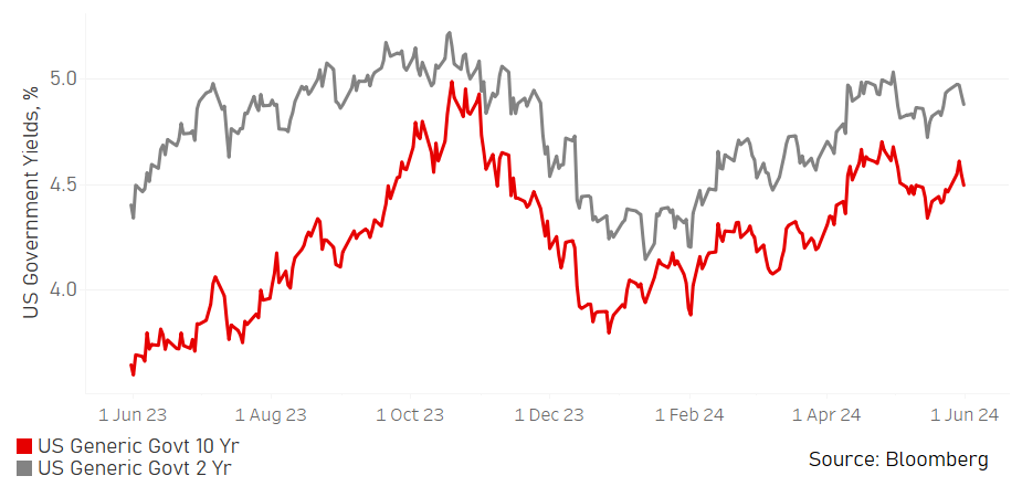
WEIGHTED PMI AND ISM INDICES

Japanese yen
|
Spot close 31.05.24 |
Q2 2024 |
Q3 2024 |
Q4 2024 |
Q1 2025 |
|
|
USD/JPY |
157.22 |
154.00 |
152.00 |
150.00 |
148.00 |
|
EUR/JPY |
170.52 |
166.30 |
167.20 |
168.00 |
165.80 |
|
Range |
Range |
Range |
Range |
||
|
USD/JPY |
150.00-165.00 |
148.00-163.00 |
146.00-161.00 |
144.00-159.00 |
|
|
EUR/JPY |
162.00-176.00 |
160.00-174.00 |
158.00-172.00 |
156.00-170.00 |
MARKET UPDATE
In May the yen strengthened very modestly versus the US dollar in terms of London closing rates from 157.45 to 157.22. However, the yen weakened versus the euro, from 168.35 to 170.52. The BoJ did not meet in May and hence left its monetary stance unchanged after the major changes announced in March that essentially brought to an end the QQE/NIRP policy framework adopted in 2013 (QQE) and enhanced in 2016 (NIRP). With the BoJ now paying 0.10% on excess reserves, the unsecured overnight call rate settled at close to 0.08%. BoJ JGB purchases per month remained at around JPY 6trn per month.
OUTLOOK
The yen advanced versus the dollar in May, but marginally and was the worst performing G10 currency. Appetite for carry was strong with FX volatility at very low levels and this fuelled JPY underperformance along with CHF. It’s difficult to see performance turn better over the short-term with yields so low. An event that fuels increased market volatility and/or increased speculation of Fed rate cuts will be required. The BoJ does appear to be shifting its thinking and signalling more clearly the potential for further rate cuts. Governor Ueda gave a speech on 8th May in which he cited “pronounced labour shortages” that meant firms were raising wages even in difficult business conditions. Deputy Governor Uchida in a speech on 27th May stated that labour conditions in Japan had changed “structurally and irreversibly” which could well mean going forward that the “social norm” of mild deflation could be coming to an end given wages were likely to continue growing. Board member Seiji Adachi spoke of the potential for hiking rates if JPY depreciation alters the inflation risks notably. Hawkish rhetoric though is not enough to turn the yen stronger and action by hiking rates, commencing QE tapering and then QT and providing guidance on the potential for further rate hikes will be required to lift the implied market BoJ terminal rate that could then offer greater support for the yen.
We expect a 15bp rate hike in July but in June it now looks likely that the BoJ will signal the start of a gradual run-down on monthly JGB purchases, which currently stands at about JPY 6trn. The BoJ will likely keep the plan flexible and hence may not provide numerical guidance on the reduction in purchases, which will be dictated by market conditions. The 10-year JGB yield broke above 1.00% in May in part in anticipation of a change. While Japan’s inflation rate has slowed, services inflation remains elevated. The Services PPI YoY rate jumped to 2.8%, the highest since 1991 when tax increase impacts are excluded. PMI Output Price indices have also risen, utility subsidies will end in May, tax cuts from June could support spending and services inflation and yen weakness will all help lift inflation in the coming months.
The yen could well be bottoming out but this is dependent on other G10 central banks avoiding the need for renewed rate hikes and on the BoJ taking the actions laid out above as wage growth and inflation becomes more sustainable
INTEREST RATE OUTLOOK
|
Interest Rate Close |
Q2 2024 |
Q3 2024 |
Q4 2024 |
Q1 2025 |
|
|
Policy Rate |
-0.10% |
0.10% |
0.25% |
0.25% |
0.50% |
|
3-Month Bill |
0.03% |
0.10% |
0.30% |
0.30% |
0.60% |
|
10-Year Yield |
1.07% |
1.15% |
1.25% |
1.30% |
1.35% |
* Interest rate assumptions incorporated into MUFG foreign exchange forecasts.
The 10-year JGB yield jumped notably in May, by 19bps to close at 1.07%, the first month-end close above 1.00% since November 2011. As mentioned above, a number of speeches and communications from the BoJ point to the increased prospect of monetary tightening going forward. The labour market lies at the heart of the potential for a more notable change in the BoJ’s monetary stance. The working age population has declined by 1mn over the past 5yrs and the increased participation in the labour market by females and older workers has stalled. The resulting shortage of labour has lifted wages, highlighted by the 1.5ppts increase in the annual growth in the ‘shunto’ wager round to 5.20%. The next step for the BoJ is likely to slow the pace of JGB purchases then to be followed by a rate hike in July (+15bps). A further rate hike (25bps) is possible by year-end or certainly in Q1 2025. Ultimately, we see the market implied pricing of the BoJ’s terminal rate moving further higher. The 3yr forward OIS rate is at 0.85% and should be notably higher. We have raised our 10yr JGB forecast profile by 15bps on average each quarter.
JAPAN INFLATION MEASURES, % YOY
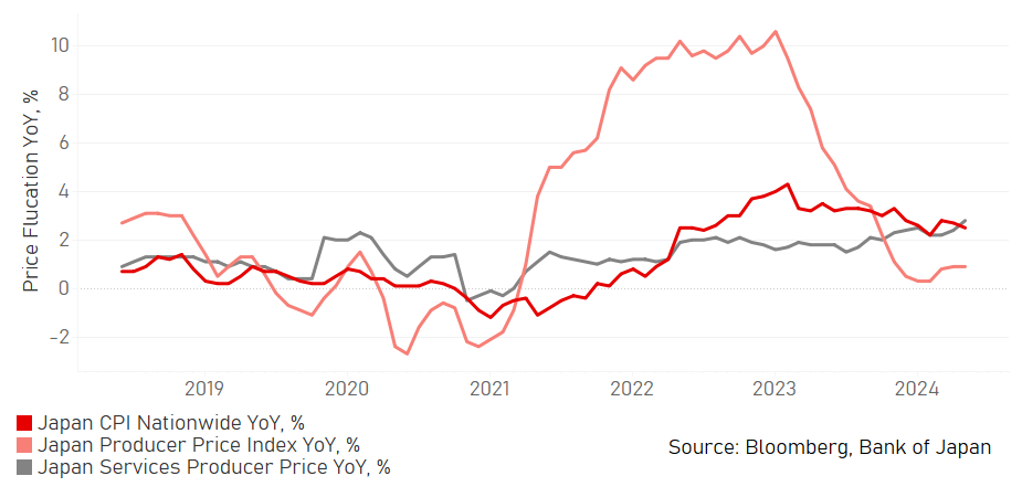
BOJ’S MONTHLY PURCHASES OF JGBS
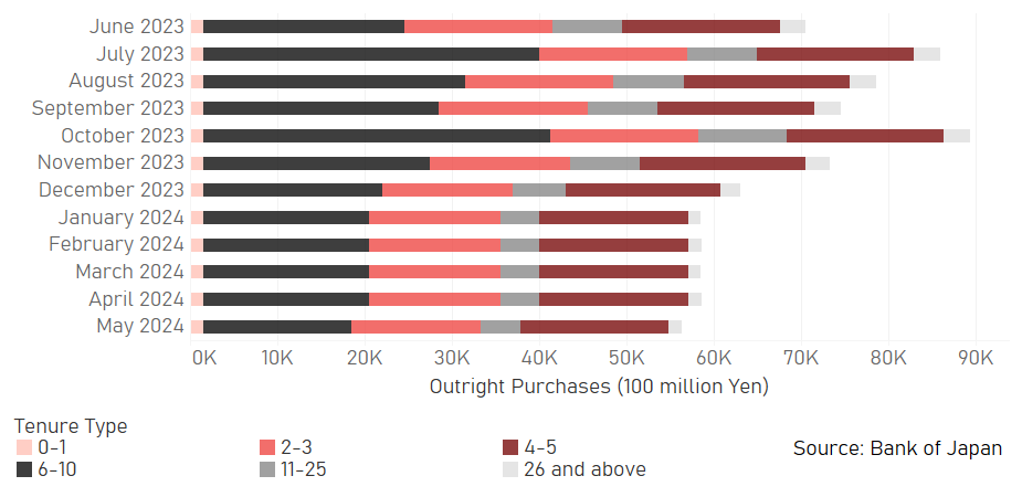
Euro
|
Spot close 31.05.24 |
Q2 2024 |
Q3 2024 |
Q4 2024 |
Q1 2025 |
|
|
EUR/USD |
1.0846 |
1.0800 |
1.1000 |
1.1200 |
1.1200 |
|
EUR/JPY |
170.52 |
166.30 |
167.20 |
168.00 |
165.80 |
|
Range |
Range |
Range |
Range |
||
|
EUR/USD |
1.0500-1.1200 |
1.0600-1.1400 |
1.0700-1.1600 |
1.0800-1.1700 |
|
|
EUR/JPY |
162.00-176.00 |
160.00-174.00 |
158.00-172.00 |
156.00-170.00 |
MARKET UPDATE
In May the euro strengthened versus the US dollar in terms of London closing rates, moving from 1.0692 to 1.0846. The ECB did not meet in May and hence the key policy rate remained at 4.00%, following 450bps of rate hikes through to September last year. The ECB is running down APP securities and will commence PEPP run-off in 2H with an estimated EUR 380bn of securities rolling off the balance sheet from both programs combined in 2024.
OUTLOOK
The euro strengthened in May and it is increasingly clear that the ECB rate cut widely expected to be delivered on 6th June will have little negative impact on euro performance. The guidance will be key of course and the incoming economic data suggest a relatively cautious guidance from President Lagarde in the post-meeting press conference. The ZEW and Sentix Economic Outlook indices point to a continued economic recovery while the euro-zone advance Composite index increased for the 6th month out of seven. The ECB’s Negotiated Wage index also accelerated from 4.5% to 4.7% and the flash euro-zone CPI data was stronger than expected driven by services CPI, which accelerated from 3.7% to 4.1%, the highest level since October last year. The euro-zone Economic surprise index relative to the US index is now at the highest since September 2021. If the ECB guidance for a rate cut in June had been less strong, the markets no doubt would have reduced the probability of a cut this month. However, the flow of data makes it much more likely that the ECB will skip cutting again at the July meeting. The OIS pricing shows just 2bps of cuts priced for July but 16bps for September. If the flow of data continues in the same vein, it is highly likely that the markets will reduce further the total amounts of cuts priced for 2024 as a whole. We now see greater risks of the ECB not delivering the three rate cuts we assume.
The macro data is clearly confirming the fact that the euro-zone economy is now through the worst impact from the huge energy price shock triggered by Russia’s invasion of Ukraine in 2022. The euro-zone’s external position is also improving dramatically, which could stand the euro in good stead in a risk-off scenario (depending of course on the event itself). ECB current account balance has swung from a record deficit to approach a record surplus in less than two years – on a 3mth annualised basis, the current account balance has gone from a deficit of EUR 274bn in September 2022 to a surplus of EUR 415bn in March. Net bond portfolio flows have also turned more positive since the end of negative rates and QE.
In recent months we have highlighted the scope for a period of decline in EUR/USD but we are now becoming more confident that window may have closed and see increasing upside risks for EUR/USD. Macro conditions are more favourable, the euro-zone external position has improved and we do not see scope for divergence and continue to see a similar trajectory for monetary policy for the ECB & the Fed.
INTEREST RATE OUTLOOK
|
Interest Rate Close |
Q2 2024 |
Q3 2024 |
Q4 2024 |
Q1 2025 |
|
|
Policy Rate |
4.00% |
3.75% |
3.50% |
3.25% |
3.00% |
|
3-Month Bill |
3.71% |
3.65% |
3.40% |
3.00% |
2.70% |
|
10-Year Yield |
2.66% |
2.65% |
2.50% |
2.40% |
2.30% |
* Interest rate assumptions incorporated into MUFG foreign exchange forecasts.
The 10-year bund yield jumped further in May, by 8bps to close at 2.66% - from an FX perspective the relative move versus US Treasury yields was notable. The US Treasury 10-year declined modestly in May, so the spread narrowed by 27bps to close May at 183bps – that’s the narrowest spread since March. The flow of data as mentioned above is certainly leading to greater conviction amongst investors that the upturn in growth is real and sustainable. This is unfolding at the same time as the ECB is about to cut rates for the first time which is supporting a steepening of the yield curve, outright and relative to the US. We still expect inflation to ease gradually toward target and by a degree that allows the ECB to cut by 25bps on three occasions. However, there are increased risks building that the ECB could deliver less than expected given the wage data, sticky inflation data and overall activity data released in recent weeks. Longer-term yields will also be supported by the start of PEPP securities rolling off the ECB’s balance sheet. This start in PEPP roll-off is in contrast to the slowdown in roll-offs from the Fed and possibly the BoE. That is supportive of euro-zone yields falling by less than in the US and UK.
ZEW AND SENTIX ECONOMIC OUTLOOK INDICES
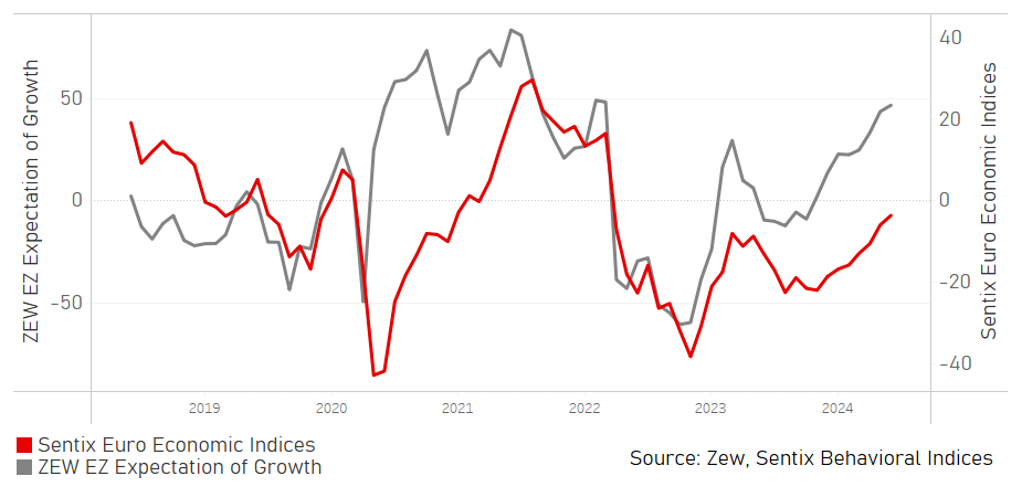
EURO-AREA CURRENT ACCOUNT BALANCE
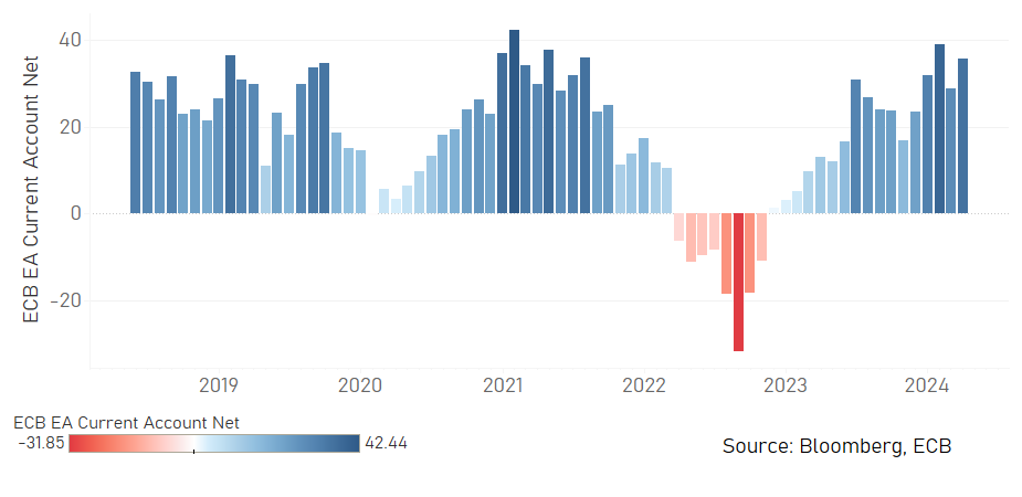
Pound Sterling
|
Spot close 31.05.24 |
Q2 2024 |
Q3 2024 |
Q4 2024 |
Q1 2025 |
|
|
EUR/GBP |
0.8523 |
0.8500 |
0.8550 |
0.8600 |
0.8700 |
|
GBP/USD |
1.2725 |
1.2710 |
1.2870 |
1.3020 |
1.2870 |
|
GBP/JPY |
200.06 |
195.70 |
195.60 |
195.30 |
190.50 |
|
Range |
Range |
Range |
Range |
||
|
GBP/USD |
1.2300-1.3100 |
1.2350-1.3200 |
1.2400-1.3300 |
1.2450-1.3400 |
MARKET UPDATE
In May the pound strengthened notably against the US dollar in terms of London closing rates from 1.2524 to 1.2725. However, the pound strengthened more marginally against the euro, from 0.8537 to 0.8523. The MPC at its meeting in May left the key policy rate was unchanged at 5.25%, following 14 consecutive rate increases through to August last year before commencing a pause from September.
OUTLOOK
The pound advanced versus the US dollar but more notably advanced on a trade-weighted basis with the BoE TWI on 28th May closed at the highest level since the plunge of the pound on 24th June 2016 when the UK left the EU. Coincidentally, this milestone was reached just after PM Sunak announced a general election will be held on 4th July. The FT Poll Tracker (Aggregation of national polls) has the Labour Party over 20ppts ahead of the Conservative Party. The only uncertainty for the markets is what extent the Labour Party victory will be. Pollsters estimate that around a 14ppt margin of victory will be required for the Labour Party to obtain an overall majority in parliament. Labour currently hold 205 seats versus 346 for the Tories in the 650-seat parliament. The swing to Labour needed for a majority is estimated by Bloomberg to be 12.5-13%, which is larger than the 10.2% swing in Tony Blair’s famous 1997 victory. If the Tories close the gap in the polls, markets may consider a hung parliament scenario. Even then though, while less stable would likely be viewed as more stable than what has been the norm over the recent post-Brexit period.
The key driver for the pound remains yields and May saw expectations of rate cuts by the BoE this year decline further. The market now expects 34bps of cuts, down from 40bps at the end of April and 60bps around mid-May. The primary catalyst for the reduction has been the disappointing CPI data. The large and expected headline drop masked a sticky services inflation print with the annual rate only declining from 6.0% to 5.9%. The BoE at its meeting on 9th May had estimated a drop to 5.5%. The doves are beginning to influence the MPC more with the vote in May 7-2 with Dave Ramsden joining Swati Dhingra in voting for a cut. The MPC was more optimistic on the inflation outlook and signalled that every meeting was “live”, including June. The CPI data has put paid to a June cut (as has the election date) so we have pushed back our call for the first cut to August. That is only partially priced now so there is scope for yields to decline as that prospect gets priced more.
The delay to a BoE rate cut has helped the pound as has the evidence of the UK economy recovering with Q1 GDP (0.6% Q/Q), the PMI data and CBI Retail Sales all pointing to growth ahead. But inflation in the UK was more supply-side driven and with the labour market showing signs of weakening, we expect the BoE to start cutting in August and there remains scope for three rate cuts this year as inflation stabilises close to target. That implies to us a similar path to the ECB and potentially the Fed and hence we are sceptical of the scope for GBP outperformance vs EUR.
INTEREST RATE OUTLOOK
|
Interest Rate Close |
Q2 2024 |
Q3 2024 |
Q4 2024 |
Q1 2025 |
|
|
Policy Rate |
5.25% |
5.25% |
5.00% |
4.50% |
4.25% |
|
3-Month Bill |
5.30% |
5.30% |
4.95% |
4.40% |
4.10% |
|
10-Year Yield |
4.32% |
4.30% |
4.10% |
4.00% |
3.85% |
* Interest rate assumptions incorporated into MUFG foreign exchange forecasts.
The 10-year Gilt yield ended May close to unchanged (-3bps) which masked a large move during the month – first a drop of 30bps before that was then recouped in the second half of the month. The UK CPI data played a part in the move back higher in yields while the strong correlation with US Treasury yields also influenced yields higher. We suspect yields are close to peaking out although the peak may not come until the 2023 highs around 4.75% are retested. Wage growth data will be important in shaping inflation expectations and declining labour market demand will likely help ease wage pressures over the coming months. The CPI data in June will come the day before the MPC meeting and assuming services inflation subsides, the MPC guidance should signal openness to a possible August rate cut. Pressure on the BoE to slow or end its QT program could build over the coming months with the weekly repo operations highlighting tightening liquidity conditions. In May there was a record GBP 17.2bn of lending to banks with upward pressure on short-term rates building. This could compromise the BoE policy stance and lead to an end to Gilt sales by the BoE – a scenario that will help further to push 10yr Gilt yields lower.
TRADE-WEIGHTED GBP PERFORMANCE
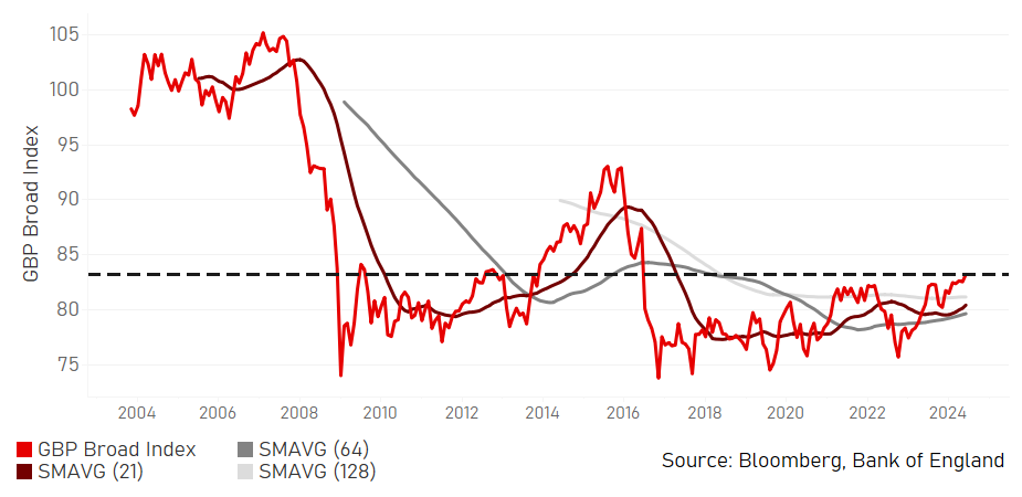
UK CPI GOODS VS. SERVICES, % YOY
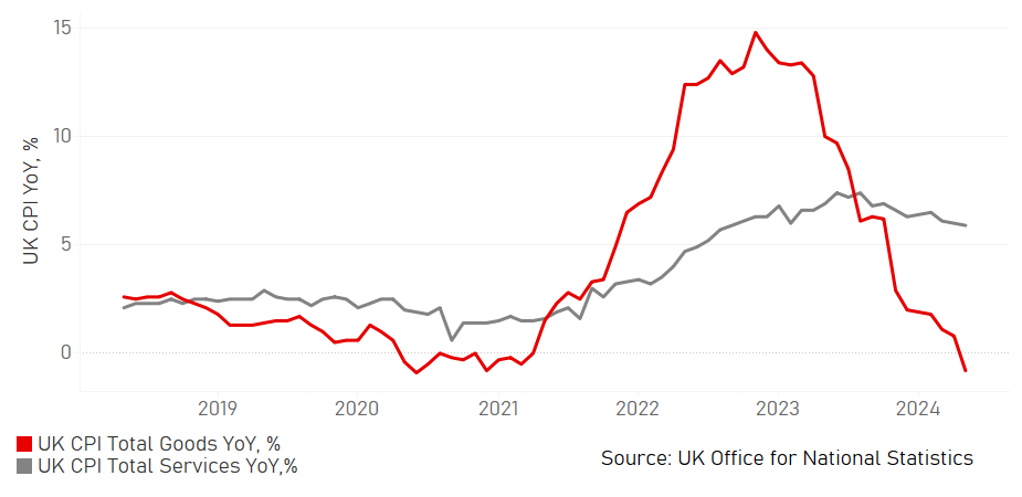
Chinese renminbi
|
Spot close 31.05.24 |
Q2 2024 |
Q3 2024 |
Q4 2024 |
Q1 2025 |
|
|
USD/CNY |
7.2421 |
7.2400 |
7.2200 |
7.1800 |
7.1500 |
|
USD/HKD |
7.8198 |
7.8100 |
7.8000 |
7.7900 |
7.7900 |
|
Range |
Range |
Range |
Range |
||
|
USD/CNY |
7.1500-7.3300 |
7.0500-7.3300 |
7.0000-7.3200 |
6.9500-7.3100 |
|
|
USD/HKD |
7.7800-7.8500 |
7.7800-7.8500 |
7.7700-7.8400 |
7.7700-7.8400 |
MARKET UPDATE
In May, USD/CNY increased marginally from 7.2405 to 7.2421. The PBOC kept the 1-year MLF stable at 2.50% on 15th May and held both its 1-year LPR rate and 5-year LPR rate unchanged at 3.45% and 3.95% respectively on 20th May. On 17th May, the Ministry of Finance issued the first batch of 2024’s ultra-long-term special Treasury bonds, with a maturity of 30 years, an issuance size of 40 billion yuan, a weighted winning bid interest rate of 2.57%, and a subscription multiple of 3.90.
OUTLOOK
Unlike some of its Asian peers, CNY did not strengthen against the US dollar, amid a 1.3% decline of US dollar. This reflected the market’s focus on the release of weaker-than-expected China April key economic indicators and the magnitude of policy stimulus. April data implied that the Chinese economy extended the weak performance of March, with real estate sector continuing its drag on the overall economy. Industrial production outperformed the market consensus expectation and delivered an acceleration of growth in April, but domestic consumption appeared on a quite slow recovery pace, judging by the smaller and near zero sequential improvement of 0.03%mom of retail sales. The property market didn’t yet stabilize with most of the major activity indicators having a sequential contraction and a large year-over-year decline in April. For year-to-date value, growth of property investment decelerated to -9.8%yoy ytd in April from -9.5%yoy ytd in March, growth of property sales decelerated to -28.3%yoy ytd in April from -27.6%yoy in March. The government reacted swiftly to the weak data. Various policies and policy plans rolled out on 17th May, especially for the property sector, including policies lowering the down payment ratios for first and second home purchases, removing the minimum mortgage rates and establishing a fund of RMB300 bn for SOEs to purchase the completed housing stocks and turn those into social housing. Equities reacted positively initially but soon gave back the gains. At the end of May the Shanghai Shenzhen CSI 300 index closed 1% lower than prior to the policy announcements.
The 49.5 manufacturing PMI and 51.1 non-manufacturing PMI readings for May alerted the market about the economy’s performance in May. Market participants likely continue to witness some disappointing economic indicators for May. Part of the reason for the recent weakness of the economy was due to the low growth of government spending and delayed government bond issuance. China’s general government spending in the first four months of this year only grew 3.5%yoy, much slower than last year’s 5.4%. We expect some improvement in fiscal spending and a quicker pace of government special bonds issuance in June and ahead, to support the economy and the currency. With USD/CNY fixing at above 7.1100 in the past week, and the 1-month interbank rate of CNH declining to 2.53% from above 5.00% in mid-April, the PBOC appears to be not fighting much against market forces more recently. USD/CNY likely will remain largely around the current level in very near term, but more signals of growth recovery would provide support for the currency.
INTEREST RATE OUTLOOK
|
Interest Rate Close |
Q2 2024 |
Q3 2024 |
Q4 2024 |
Q1 2025 |
|
|
Loan Prime Rate 1Y |
3.45% |
3.35% |
3.25% |
3.25% |
3.25% |
|
MLF 1Y |
2.50% |
2.40% |
2.20% |
2.20% |
2.20% |
|
7-Day Repo Rate |
1.80% |
1.70% |
1.60% |
1.60% |
1.60% |
|
10-Year Yield |
2.32% |
2.40% |
2.47% |
2.55% |
2.60% |
* Interest rate assumptions incorporated into MUFG foreign exchange forecasts.
Chinese government bond yields have been hovering at a low rate of 2.3% in May. Slower issuance of government bonds was one of the key reasons for keeping yields low. In the context of local governments trying to reduce the debt burden, it gets clearer that the central government is taking over the responsibility from local governments to increase leverage. On 17th May, the Ministry of Finance issued the first batch of 2024’s ultra-long-term special treasury bonds, and according to the issuance plan disclosed by the Ministry of Finance on 13th May, this year’s ultra-long-term special treasury bonds mainly have three maturities: 20Y, 30Y and 50Y, and it will have 22 issues in total. Judging from the issuance rhythm, this year's CNY 1 trillion of ultra-long-term special treasury bonds are planned to be issued in the seven months from May to November, with four issues in June, August, and October respectively, and three in July and September seperately, and two issues in May and November respectively. The issues seem more evenly distribted rather than concentrated. With this increased supply, we expect some modest increase in China’s 10-year bond yield through the rest of this year, despite a modest rate cut.
MAY CHINA PMIS DECLINED, WITH MANUFACTURING PMI FALLING BELOW 50
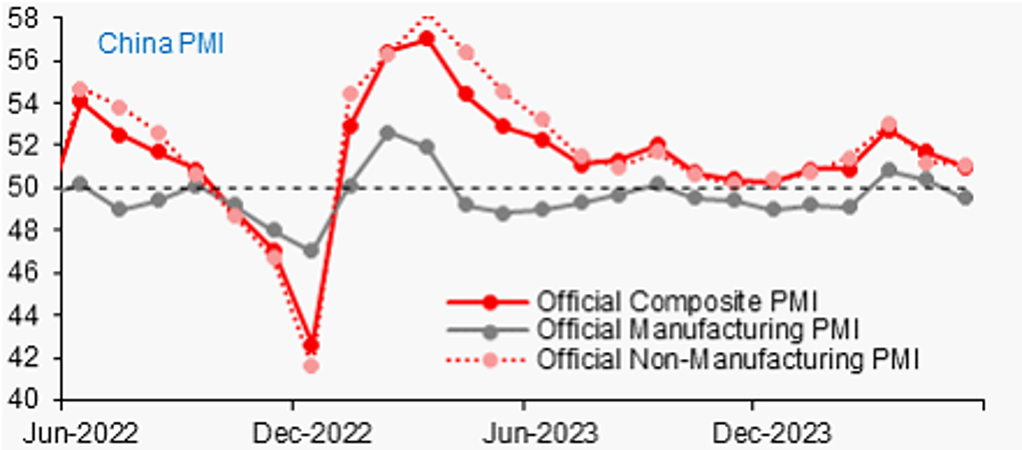
Source: CEIC, MUFG GMR
USD/CNY FIXINGs WERE AT 7.1100 AND SLIGHTLY ABOVE RECENTLY
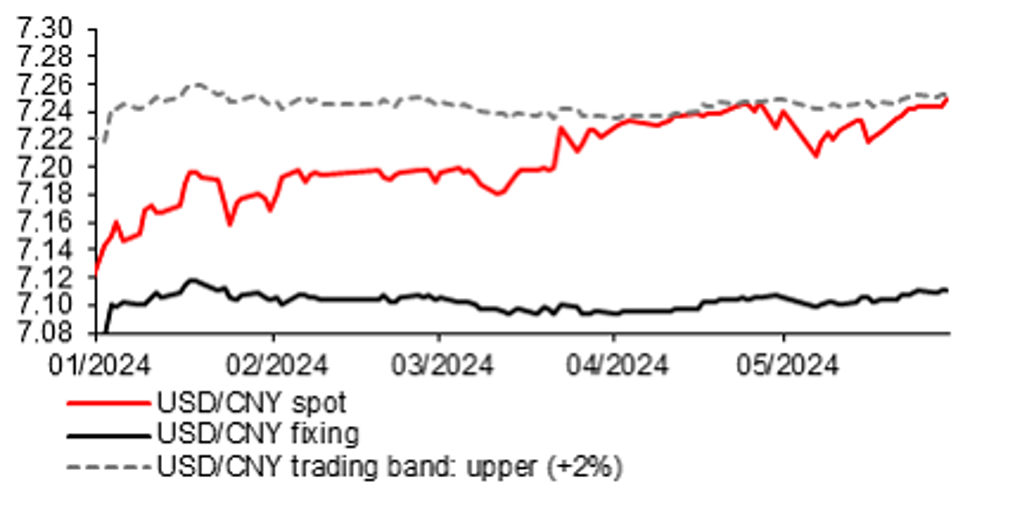
Source: CEIC, MUFG GMR
